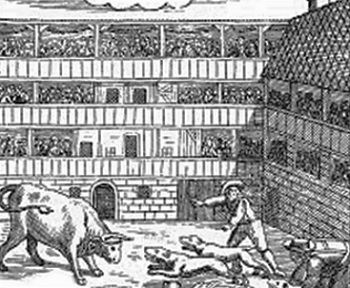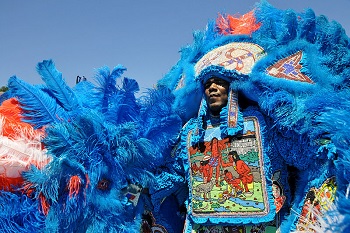6 Fun Activities That Were Horrifying Throughout History

In the eyes of us jaded 21st-Century future folks, the past always seems like a more innocent place, filled with ice cream socials, long walks in parks, and playing games to distract one another from the Plague. Back then, people were at their happiest when they could indulge in some sweet, wholesome fun for the whole family. But activities that we might consider boring or lame weren't always as wholesome or innocent as we picture them. Pick even the tamest weekend activity out of the divorced dad's guidebook, and you'll find that the nearest equivalent in olden days was a horrific, inhuman distortion of what we have today. For instance ...
In Elizabethan England, Instead Of Going To The Zoo, People Watched Bears Fight To The Death
Zoos don't get enough credit for what wondrous, insane places they are. A mere few hundred years ago, if people wanted to see a bear, they had to rub themselves in salmon and take a one-way trip to the nearest woods. Now the weirdest, fiercest creatures are hanging out right here in our cities, next to the good Starbucks. But in Renaissance-times England, people weren't satisfied with simply getting to look at a dangerous animal like a bear. Instead, they wanted to see it in its natural, predatory state. That's why they chained them to stakes, unleashed packs of vicious dogs on them, and cheered as they watched the blood flow. Ah, the simple pleasures of going to the zoo.

All bears grow chains and stakes after cubhood. It's only natural.
In England, the baiting of bears (and bulls when they'd run out of bears) wasn't some secret underground thing, like modern-day dog fighting. Instead, it was a pastime enjoyed by all. Contemporaries described it as "pleazaunt," and the government declared that it was "a sweet and comfortable recreation fitted for the solace and comfort of a peaceable people" -- the kind of "peaceable people" who enjoy animal blood sports.
It was part of the fabric of English society, and beggars and noblemen alike visited the special "bear gardens" to watch bears fight for their lives against packs of giant mastiff hounds. It was even popular with the monarchy, as Queen Elizabeth I once vetoed an attempt by Parliament to ban bear-baiting on Sundays, because how could one possibly honor the day of the Lord if not by viciously slaughtering a few of His noble creations?

"Medammit." -- God
Occasionally, when Elizabethans got bored with the repetitive bear murdering, they decided to get more creative with their inhumanity. While visiting London in 1544, Don Manrique de Lara, third Duke of Najera, wrote about watching an ape tied to the back of a pony getting attacked by dogs, finding it "very laughable" to see the ape screaming in terror as the pony was being ripped apart -- because that's exactly what someone who has a name like a Zorro villain would say and think.
Eventually, the bears became quite the celebrities. Shakespeare even wrote a bear in as a deus ex murder machine in The Winter's Tale, and makes numerous references to bear-baiting in The Merry Wives of Windsor. Shakespearean theater and bear-baiting actually had a very close relationship. Paris Gardens, a popular London bear-baiting arena, was next to the Globe, Shakespeare's home theater, and prominent theater folk like Philip Henslowe and Edward Alleyn were Masters of the Game. In fact, in compliance with decrees from the Privy Council, theaters would shut down on Thursdays and Sundays to encourage people to spend more money on bear-baiting, which is like if Congress passed a law that Netflix had to shut down on Sundays so that we'd all watch HBO pay-per-view bumfights.

"It's not TV. It's the downfall of society."
Bear-baiting wasn't banned until 1835, though not without earlier resistance from Parliament. Part of the disgraceful delay was because people suspected the ban was a conspiracy by Methodists and Jacobins to deprive people of their fun so that they'd be susceptible to anti-nationalism. If your patriotism only gets activated by the smell of fresh bear blood, we're on the side of the Jacobins. Maybe try fireworks instead?
Racism Turned Mardi Gras Parades Into Massive Street Fights
Quick: What do you think of when you hear the words "Mardi Gras"? Bright colors? Authentic bayou cooking? One of the last bastions of carefree excess?

You were thinking of boobs, weren't you?
Mardi Gras feels like it belongs in another time. It is the one big American celebration which prides itself on letting people be free from the confines of modern morality, a moment in time when the rules become less important and people get to do whatever feels good. Unfortunately, in the early 1800s, that feel-good vibe in New Orleans was to be violently racist. Even after the end of slavery, black people were excluded from Mardi Gras festivities. As a response, the black community began holding their own parades. The African-American Carnival was quickly established, and was dubbed "the parade most white people don't see" -- except that they were less like normal fun parades and more like vicious street gangs.
To celebrate their new American heritage, the oppressed black community turned to their Native American counterparts for Carnival inspiration. Each black neighborhood created its own Indian tribe, like the "Yellow Pocahontas" or "The Keepers of the Flame," and dressed accordingly during the celebrations. One of the most important parts of being a Mardi Gras Indian was the costume, which they originally adorned with bottle caps and fish scales, but over the years became more and more elaborate. Today, a proper Carnival Indian costume can set their wearers back thousands of dollars and dozens of hours of sewing. "Kill 'em dead with needle and thread," became a saying in the later years of the parade, denoting that even when armed with knitting needles, the Mardi Gras Indians were always out for blood.

Now you don't need to scale the cages at the zoo to get your ass kicked by an angry peacock.
The Mardi Gras Indians took their cosplay very seriously, creating hierarchies and positions mirroring the ceremonial ones in the white Mardi Gras -- the difference being that these roles had a very real, combat-oriented purpose. There were roles like the "spy boy," who served as a lookout to spot other gangs, or the "flag boy," whose job it was to relay messages between the spy boy and the "big chief" in order to logistically optimize the violence. Once two tribes met on the streets, a massive brawl quickly ensued.

"Ax boy" usually won.
By the 1970s, most of the remaining big chiefs decided to put the violence in the rear-view mirror. The costumes remained, but the tribes had put an end to their fighting, instead choosing to showcase the tribes' spirits by competing to have the most elaborate costumes and performing sacred dance battles.

The spirit of his tribe and Hulkamania go on.
Flea Circuses Were Miniaturized Animal Torture Tents
The circus is a highly controversial tradition which bundles whimsical clowning, feats of dexterity, and the horrifying treatment of animals all together into a magical afternoon with the kids. But back in the day, for those who couldn't afford to go and watch a frightened lion limp through a burning hoop, there were the flea circuses, which were just like a real circus, but with everything smaller -- except their rap sheets on animal abuse.
As with real circuses, it was all downhill from the posters. Flea circus operators made amazing promises to their future audiences, basically claiming that they had turned these tiny insects into miniature humans who could race, tightrope walk, and even engage in swordplay. The only problem with those promises is that, of course, fleas can't be trained to do anything at all. This is an opinion shared by the flea's ringmaster, these so-called "professors" (they had a B.S. in BS) who had to resort to some inventive animal cruelty to create the illusion of a performance.

It was a simpler time. "Simple" being the operative word.
The fleas' deft interaction with the miniature props surrounding them was not by choice. To make the fleas appear as if they were interacting with props, the poor little guys were glued to the items. Then, to get the fleas to move around, their little metallic circus ring would get increasingly hot, making them desperately flee to the edges of the platform, only to be dragged down by the tiny replica of a Victorian carriage. Surely, if that's what it takes to get a bunch of bugs to wriggle about a bit, that's the point when you call the whole experiment a bust and go back to trying to launch that insect air show by getting bees to fly in formation.

And yet they look oddly peaceful.
At some point in the 20th Century, society collectively decided they shouldn't encourage the type of people who used to tear the wings off flies, and flea circuses slowly ebbed away. For a time, a new type of flea circus popped up, one inhabited solely by tiny mechanical versions of the itchy bugs, with the show being completely automated. The fad didn't last for very long, though -- almost as if it stopped being fun when people realized it wasn't at the expense of dozens of tiny creatures writhing in agony.
For A Spooky Time, Insane Asylums Doubled As Haunted Houses
Not too long ago, a haunted house was not much more than that one house in your neighborhood which dangled a few plastic skeletons in your face before they let you have the candy on Halloween. Now, professional haunted houses are a serious business. You can easily find a very abandoned, very haunted former insane asylum to wander around in -- and with no breaking and entering required. For some pocket change, you can pay a bunch of entrepreneurial college kids to scare you half to death as they guide you through the exact spots where some 19th-Century tortured souls were "cured" by having the smartest people in the world shove electric cattle prods inside them. But if you lived in the 1700s, you could have still done that, with the added bonus of being able to see, hear, and smell those poor saps' burning flesh.

It's like a pig roast, only the people paying to see this are the real pigs.
Historians believe the first asylum to open its doors to the general public was the Bethlem Royal Hospital in London, known to the commoners as "Bedlam" -- not because the wardens had a sick sense of humor, but because the hospital's name is the origin of that word meaning "utter chaos." When the attending public was granted access to the hospital, all bets were off. People would come over to gawk, mock, and participate in the torture to their twisted heart's desire.

"Kids get in free!"
At first, the hospital claimed that opening the facilities to the public would be a solace to the inmates, letting their family and friends drop in and bring them food and other comforts. Yet some argued that this move was more of an attempt for the asylum to shore up some more funding. Letting in people with thick wallets but absolutely no relations of any of the patients didn't help the asylum's reputation for having a "corporate culture." Proof that people were only there to stare at the animals in his zoo of human misery is best described by Frenchman Cesar de Saussure in his letters about what a shitshow London used to be:

It's rare that someone gets robbed and we don't feel bad for them, yet here we are.
Mini-Golf Courses Used Caged Baby Bears As Hazards

Miniature golf is awesome. It might just be the cleanest, healthiest fun you can have tapping balls with a stick. But mini-golf wasn't always as family-friendly as it is today. Originally, it was specifically designed for women, because regular golf was deemed to be such a manly, raw, intense, testosterone-heavy sport that no mere woman could handle it. How ironic, then, that these frail, teacup-sized golf courses eventually become more metal than any country club green could ever be, as some putt-putt golfers soon found themselves puttering around with living bears.
You have to really go out of your way to make something like mini-golf cruel, but in the 1930s, they finally found a way. During the Great Depression, for a hot minute, crazy golf had become a very fashionable pastime. Suddenly, the rich and famous swarmed to the tiny greens to enjoy the latest fad. In order to cater to the tastes of the their fancy new clientele, course owners decided to up their game by creating outlandish hazards, like a full-sized Hula hut or having steam rising out of the course.

Don't forget the biggest hazard of all: the Persistent Mansplainer.
One Californian smooth operator named Bearl Sprott, invoking the spirit of his Elizabethan ancestors, came to the conclusion that any leisure experience becomes that much more enjoyable if the torture of a bear is somehow part of it. That is why, as one of the hazards, Sprott positioned a bear cub in a cage in the middle of the green. Golfers would have to aim their shots directly through the cage, while the bear would attempt to stop the ball as it whizzed by. In order to get the bear to play along, the golfers had to first dip their golf balls in honey and syrup, turning it into the world's most disappointing Ferrero Rocher.
Like the adrenaline junkies they were, mini-golfers eventually did away with the cage, chained the poor bear to a post, and let it wander around the course for their amusement. Remind us again how this is a much less intense sport than regular golf?

"Do not bribe the hazard. Do not look like Leonardo DiCaprio."
People Used To Feed Animals To Other Animals
It sure looks like there's no innocent, family-friendly present-day pastime that wasn't at one point twisted by history's madness. But there must be some activity so gentle, so innocuous, so boring that the past couldn't have corrupted it. Like feeding the ducks in the park! Surely, there's no way to corrupt going to a park and feeding the animals, right? Unless you changed the animals to dangerous predators, and change what you're feeding them from breadcrumbs to other, smaller animals. Which is exactly what 17-Century Londoners used to do. Seriously, Past England, what was it with you guys and animal cruelty?
Back in the day, royal families would collect exotic animals like they were Pokemon. Not that they were left with much of a choice. For foreign dignitaries, presenting kings and queens with exotic animals from their homeland was their version of handing over a giant airport Toblerone. After a few years on the throne, most monarchs had a collection of fantastical animals that would rival any modern zoo. And on rare occasions, when the royals weren't home, these menageries were opened to the public. And when we say open, we mean open. Often, many of the creatures -- among them elephants, apes, and lions -- were allowed to roam the gardens quite freely, giving visitors the opportunity to go and play with them. Play. With lions. If that were to happen today, we don't know who should be more afraid for their lives, the people or the animals.

"Hey, kid, wanna try the head-in-the-mouth trick?"
Even though the menageries had occasional visiting hours, only the nobility was in a position to readily afford admission. In England, one of the most popular of these menageries was in the Tower of London, which, when it wasn't serving as a dungeon or gift shop, housed an impressive collection of big cats. Believing that the wonder of a broken-spirited animal should be enjoyed by all, the English Crown figured out an alternate form of payment. Whoever didn't have the coin for a ticket could pay in cats and dogs. In return for keeping their maintenance costs down, the Tower of London gladly admitted people who provided food for the big cats living inside, and that food most often turned out to be their very own pets. That's the dictionary definition of trading up: sacrificing your house cat for a lion.

"Please don't tip the attendants except in dogs and cats, please."
Eventually, the public feeding of these big cats became so commonplace that the lions would become restless during days the zoo was closed, roaring and kicking up such a ruckus until an attendant came and paid them some attention. It's safe to assume that said "attention" came in the form of a few extra poodles.
If you thought that was bad, you should see Carolyn's Twitter.
Also check out 9 Unintentionally Terrifying Old-Timey Children's Toys and 10 Old-Timey Medical Treatments Inspired By Your Nightmares.
Subscribe to our YouTube channel, and check out 6 Insane Stereotypes That You Still See In Every Movie, and other videos you won't see on the site!
Follow us on Facebook, and we'll follow you everywhere.
Last Halloween, the Cracked Podcast creeped you out with tales of ghost ships, mysteriously dead people, and a man from one of the most famous paintings in U.S. history who years later went all Jack Nicholson in The Shining on his family. This October, Jack and the Cracked staff are back with special guest comedians Ryan Singer, Eric Lampaert, and Anna Seregina to share more unsettling and unexplained true tales of death, disappearance, and the great beyond. Get your tickets for this LIVE podcast here!






